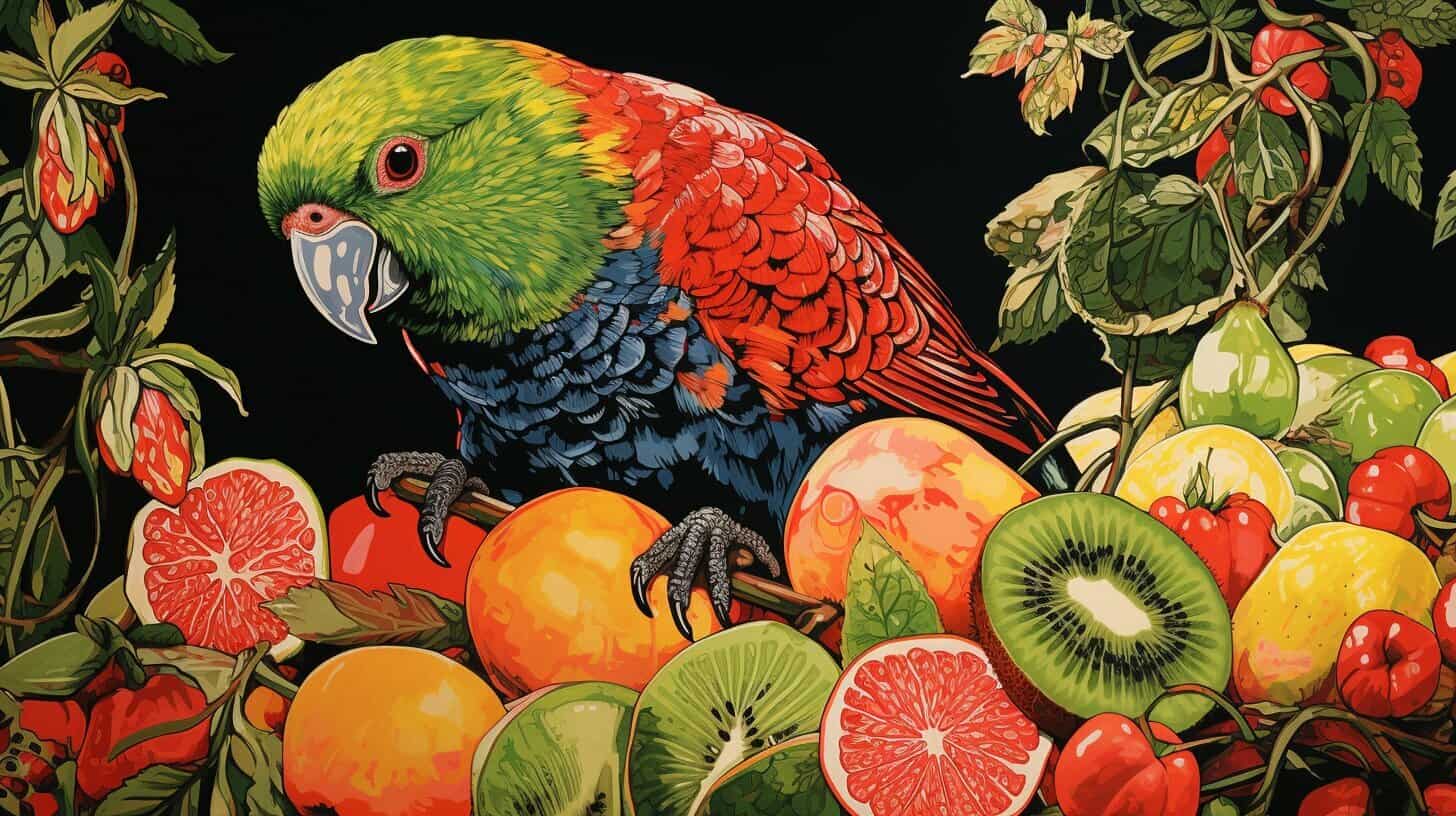As a responsible owner, you want to give your kakariki bird the best possible care, including providing them with a balanced and nutritious diet. The right food choices will keep your feathered friend happy and healthy and promote their longevity and vitality.
Feeding your kakariki the appropriate food is crucial, as they have specific dietary needs that must be met to maintain their overall health and well-being. This article will discuss the best food for kakarikis, from their natural to commercial diets and everything in between.
By the end of this article, you will clearly understand what to feed your kakariki and how to do it safely and healthily. Let’s get started!
Understanding the Kakariki Diet
Kakariki birds are omnivores, and in the wild, they feed on various foods, including seeds, fruits, and insects. To keep your feathered friend healthy and happy, it’s crucial to understand their natural diet and try to replicate it as closely as possible in captivity.
When it comes to feeding your kakariki, you’ll need to provide a balanced diet that includes all the essential nutrients they need. This means incorporating a range of different foods and paying particular attention to their intake of protein, vitamins, and minerals.
| Food Groups | Key Nutrients |
|---|---|
| Seeds | Protein, Fat, Vitamins, and Minerals |
| Fruits and Vegetables | Vitamins, Minerals, and Fiber |
| Animal-Based Protein | Protein and Fat |
| Pellets and Commercial Foods | Complete Nutrition |
In the wild, kakariki primarily feed on various seeds, including grass seeds, and they have a particular preference for the seeds of native New Zealand flax. For this reason, seeds should make up a significant portion of their diet in captivity.
However, it’s essential to remember that not all seeds are created equal regarding nutrition. For example, sunflower seeds are high in fat and low in nutritional value, whereas chia seeds are a good source of protein, fibre, and omega-3 fatty acids.
When introducing seeds to your kakariki’s diet, it’s best to provide a seed mix that contains various seeds to help ensure they get a balanced diet. You can also supplement their seed mix with additional types of seeds to make sure they get all the nutrients they need.
It’s also important to note that seeds alone won’t provide your kakariki with all the necessary nutrients. You’ll need to supplement your diet with fresh fruits and vegetables, and good sources of essential vitamins, minerals, and fibre.
Nutritious Fruits and Vegetables for Kakariki
Some of the best fruits and vegetables to include in a kakariki’s diet include:
- Apple
- Banana
- Papaya
- Mango
- Kiwi fruit
- Blueberries
- Broccoli
- Carrot
- Sweet potato
- Kale
When introducing new foods to your kakariki’s diet, gradually avoid upsetting their stomach. It’s also important to wash all fruit and vegetables thoroughly and remove any seeds or pits that could harm your bird.
It’s also a good idea to offer your kakariki animal-based protein sources, such as boiled eggs or cooked chicken, to help supplement their diet. However, it’s important to feed these foods in moderation and avoid feeding them raw or undercooked meat.
Finally, it’s worth considering feeding your kakariki a pelleted or commercial diet, which can provide complete nutrition in a convenient and easy-to-prepare form. Just be sure to choose a high-quality product that provides a balanced range of nutrients and avoid over-relying on these foods as the sole source of your bird’s diet.
Seeds: A Staple in the Kakariki Diet
Seeds are essential to a kakariki’s diet, providing the necessary carbohydrates, fats, and proteins. However, choosing quality seeds that will provide your feathered friend with all the nutrients they need to stay healthy is important.
When selecting seed mixes for your kakariki, opt for those that contain a variety of seeds, such as millet, canary seed, and sunflower seeds. Avoid seed mixes that are predominantly sunflower seeds, as they are high in fat and can result in obesity and other health issues.
It is also important to note that seeds alone should not make up the entirety of your kakariki’s diet. While they may enjoy eating seeds, a varied and balanced diet is crucial for their overall health and well-being.
| Seed Type | Nutritional Value | Recommended Amount |
|---|---|---|
| Millet | Carbohydrates and protein | Approximately 2 tablespoons per day |
| Canary Seed | Low in fat and high in protein | Approximately 1 tablespoon per day |
| Sunflower Seeds | High in fat and protein | In moderation – no more than 1-2 seeds per day |
Soaked Seeds
Soaking seeds in water before feeding them to your kakariki can have some benefits. Soaked seeds are more easily digestible, and the process of soaking can also help remove any dust or debris that may be on the seeds. However, discard any uneaten-soaked seeds after a few hours to avoid the growth of harmful bacteria.
Fresh Fruits and Vegetables for Kakariki
Fresh fruits and vegetables are an essential addition to a kakariki’s diet. They offer a range of nutrients and minerals not found in other foods. Feeding fresh produce also helps to keep your bird’s beak and digestive system healthy and active. However, some fruits and vegetables can harm birds, so it’s important to be aware of safe options.
Tip: Offer a variety of fresh fruits and vegetables to keep your bird interested and provide a range of nutrients.
| Safe Fruits for Kakariki | Safe Vegetables for Kakariki |
|---|---|
| Bananas | Carrots |
| Apples | Peppers |
| Papayas | Broccoli |
| Blueberries | Sweet potatoes |
When feeding fruits and vegetables, ensure they are washed thoroughly and cut into small pieces. Remove any seeds, pits, or cores, as these can harm your bird. A good rule of thumb is to offer fresh produce twice a day, in addition to seed and protein sources.
Introducing New Foods to Kakariki
Some Kakariki may be hesitant to try new foods, especially if they have only been fed a limited diet in the past. To encourage your bird to explore fresh produce, try offering small pieces alongside their regular food. You can also try incorporating fruits and vegetables into toys and puzzles, encouraging your bird to work for their food.
Tip: Patience is key when introducing new foods. Don’t give up if your bird doesn’t take to a certain food immediately. Keep offering it in small amounts until they become familiar with the taste and texture.
By providing a balanced and varied diet, including fresh fruits and vegetables, you can help ensure your kakariki bird stays happy and healthy.
Protein-Rich Foods for Kakariki
Protein is essential for maintaining healthy muscles, skin, feathers, and bones in your kakariki. In the wild, they obtain protein from insects, larvae, and small animals like lizards and snails. As a pet owner, you can provide the necessary protein through animal-based foods.
Some suitable options include:
| Food | Description |
|---|---|
| Boiled egg | A cooked egg is an excellent source of protein and is easier for kakarikis to digest than raw egg. |
| A cooked egg is an excellent protein source and easier for kakarikis to digest than raw egg. | These can be offered as a treat in moderation. They are an excellent source of protein and other nutrients. |
| Small pieces of lean meat or poultry | Chopped and cooked chicken or turkey can be offered in small amounts as a treat. Ensure the meat is free from seasoning and bones, which can pose a choking hazard. |
Note: Always ensure that your protein-rich foods are fresh and well-cooked to prevent bacterial contamination and digestive upset.
It’s best to offer protein-rich foods in small amounts and no more than twice a week. Overdoing it on protein-rich foods can cause health problems in kakariki birds. Ensure that animal-based protein does not make up more than 10% of their diet.
By providing a varied and balanced diet that includes protein-rich foods, fresh fruits and vegetables, and high-quality seed mixes or pellet diets, you can ensure that your kakariki is getting all the essential nutrients they need to thrive.
Pellets and Commercial Diets for Kakariki
While a diet consisting of fresh fruits, vegetables, and seeds is ideal for kakariki birds, many owners may supplement their diet with commercial pellets or bird food. However, choosing high-quality, balanced options is important to ensure that your feathered friend receives all the necessary nutrients.
Pellet diets are a popular choice for many bird owners. These diets typically offer a balanced mix of nutrients, making it easier to ensure your kakariki gets everything they need. However, not all pelleted diets are created equal, and choosing a high-quality option specifically formulated for kakariki is important.
Commercial bird foods, such as seed mixes, can also suit your kakariki’s diet. However, it is important to read labels and choose options high in nutritional value carefully. Avoid seed mixes that contain filler ingredients, such as cracked corn or milo, as these offer little nutritional value for your bird.
It is important to note that while pellets and commercial bird foods can be a convenient addition to your kakariki’s diet, they should not make up most of their food intake. A diet consisting mainly of pellets or commercial foods can lead to nutritional imbalances and health issues.
Choosing the Right Pelleted Diet or Commercial Food
When selecting a pelleted diet or commercial food for your kakariki, choosing a high-quality option specifically formulated for their nutritional needs is important. Look for options that include a variety of ingredients, such as fruits, vegetables, and grains, to ensure a well-rounded and balanced diet.
Read labels carefully and avoid options that contain a lot of fillers or low-quality ingredients. If in doubt, consult with your avian veterinarian for recommendations on suitable commercial foods or pelleted diets.
| Pros | Cons |
|---|---|
|
|
Remember, no single food can provide all the necessary nutrients for a kakariki’s health and well-being. A balanced and varied diet that includes fresh fruits, vegetables, seeds, and high-quality pelleted diets or commercial foods is key.
Treats and Supplements for Kakariki
While a balanced and nutritious diet is crucial for kakariki birds, treats and supplements can also enhance their health and well-being.
What treats can I give my kakariki?
Kakariki birds enjoy a variety of healthy treats, including fresh fruits, vegetables, and whole grains. Some options include apples, carrots, sweet potatoes, and quinoa. It is important to offer treats in moderation, as overfeeding can lead to dietary imbalances and obesity.
What supplements do Kakariki need?
Most essential nutrients required for kakariki are available through a balanced diet. However, some supplements may be necessary to address specific health concerns or deficiencies. Consult with a veterinarian or avian nutritionist for guidance on appropriate supplements.
How often should I give my kakariki treats and supplements?
Treats should be given sparingly, no more than once or twice a week. Supplements should only be given as directed by a veterinarian or avian nutritionist, as excessive amounts can harm your bird’s health.
What are some healthy treat and supplement options for my kakariki?
Treats and supplements should not replace a balanced and nutritious diet for your kakariki.
Water: Essential for Kakariki’s Health
Just like all living beings, kakariki birds need water to survive. As a responsible owner, it’s important to ensure that your feathered friend has access to clean and fresh water at all times.
Water is essential to hydrate your kakariki, support digestion, and regulate body temperature. Ideally, you should provide them with a water source that’s large enough to bathe in, as this allows them to keep their feathers clean and healthy.
It’s recommended to use a water dispenser with a clean and reliable water supply, as this helps prevent contamination and possible disease transmission. Changing the water daily is also important, as standing water can become a breeding ground for bacteria and other harmful microorganisms.
If you’re unsure how much water your kakariki is drinking, you can keep track of the water level in their dispenser each day. This will help you monitor their water intake and ensure they are well-hydrated.
Remember, water is just as vital as food to keep your kakariki healthy and happy. So, ensure they have a fresh and clean water source every day!
Feeding Tips and Guidelines for Kakariki Owners
Feeding your kakariki the right diet is essential for their health and well-being. Here are some tips and guidelines to help you establish a healthy feeding routine:
Establishing a Feeding Schedule
It’s important to establish a regular feeding schedule and stick to it. Kakariki birds should be fed twice a day, once in the morning and once in the evening. Avoid overfeeding your bird, which may lead to obesity and other health problems.
Portion Sizes
The food your kakariki needs will depend on size, age, and activity level. As a general guideline, a kakariki should be given 1-2 tablespoons of food per feeding. Adjust the portion size accordingly based on your bird’s appetite and condition.
Monitoring Your Bird’s Diet
Keep track of what your kakariki is eating and how much. Observe any changes in appetite or behaviour which may indicate a dietary issue or a health concern.
Adjusting the Diet
If you notice any issues with your bird’s diet, such as weight gain or loss, adjust the diet accordingly. For example, you may need to decrease the amount of food you’re feeding or change the types of food you’re offering. Consult a veterinarian if you’re unsure of what changes to make.
Introducing New Foods
When introducing new foods to your kakariki’s diet, do so gradually. Start with small amounts and monitor your bird’s reaction. If your bird refuses to eat new food, try a different variety or prepare it differently.
Clean Water
Make sure your kakariki always has access to clean and fresh water. Change the water daily, and provide it in a bowl or water bottle that is easy for your bird to access.
Feeding Treats and Supplements
Treats and supplements should be given in moderation. Offer a small amount of healthy treats, such as fresh fruit or vegetables, once a week. Supplements should only be given if recommended by a veterinarian.
Best Food For Kakarikis – Frequently Asked Questions about Feeding Kakariki
Feeding a kakariki can be a rewarding experience, but it’s important to ensure they receive the right diet to maintain their health and happiness. Here are some frequently asked questions about feeding kakariki:
Can Kakariki Eat Nuts?
Yes, kakariki can eat nuts as part of a balanced diet; however, they should be given in moderation. Nuts contain high fat, which can cause health problems if overconsumed. It’s best to offer nuts as a treat and ensure they are unsalted and given in small pieces to prevent choking.
How Often Should I Feed My Kakariki?
Kakariki should have access to food and clean water at all times. However, it’s important not to overfeed them as this can lead to weight gain and associated health problems. A good rule of thumb is to provide a measured amount of food in the morning and evening and monitor their eating habits to ensure they are not overeating.
What Can I Feed My Kakariki Besides Seeds?
Kakariki requires a varied diet to ensure they receive all the necessary nutrients. In addition to seed mixes, they can be given fresh fruits and vegetables, protein-rich foods such as cooked eggs and lean meats, and high-quality pelleted diets. However, research new foods before offering them to your kakariki, as some may be toxic or inappropriate.
Can Kakariki Eat Bread?
Bread should not be a staple of a kakariki’s diet, as it contains little nutritional value and can lead to digestive problems if overconsumed. However, small pieces of bread can occasionally be given as a treat.
Do Kakariki Need Supplements?
Kakariki do not necessarily need supplements if they are receiving a balanced and varied diet. However, supplements such as calcium and Vitamin D3 may be necessary if they are not receiving enough of these nutrients from their food. Be sure to consult with a veterinarian before giving supplements to your kakariki.
How Do I Know If My Kakariki Is Over or Underweight?
Monitoring your kakariki’s weight is important to ensure they are not over or underweight. You can do this by gently feeling their breastbone – if it is easily felt and not prominent, they are likely a healthy weight. They may be underweight if the breastbone is very pronounced or difficult to feel. They may be overweight if it is difficult to feel due to excess fat. Consult a veterinarian if you have concerns about your kakariki’s weight.
How Often Should I Change My Kakariki’s Water?
It’s important always to provide your kakariki with clean and fresh water. Water should be changed at least once a day, or more frequently if it becomes soiled or contaminated. Water bowls should also be cleaned regularly to prevent the growth of harmful bacteria.
Can Kakariki Eat Avocado?
No, avocados are toxic to kakariki and should never be given to them.



Have comments or questions about this article? Then get involved!
Spotted an error or something we have missed? Let us know